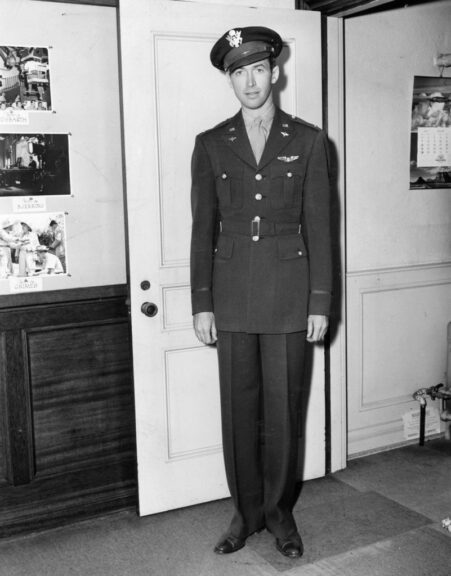Jimmy Stewart, A World At War, And Why ‘It’s A Wonderful Life’ Was Almost Less Wonderful: Part I
This article was previously published on December 20, 2023.
The beloved Christmas classic film “It’s a Wonderful Life” was the movie that brought a beleaguered and combat-weary actor James “Jimmy” Stewart back to fans after the war — but it may have also been the movie that brought a desperate man back from the brink.
James Maitland Stewart was preparing to go to war for several years before he was drafted in 1941. He earned a civilian pilot’s license in the hopes that the Army would let him fly — and he even took a trip to Europe in 1939 to get a feel for the landscape, knowing that it was likely he would end up there at some point.
By the time the Empire of Japan launched its surprise attack on the American naval base at Pearl Harbor, Hawaii, Stewart had already attempted to join the Army. Rejected once in 1940 because he was underweight, the always-slim actor attempted to pack on a few pounds and ultimately turned to a doctor for a note explaining that he was just genetically predisposed to be thin.
Biographer Robert Matzen — who wrote “Mission: Jimmy Stewart and the Fight for Europe” — explained, “Step by step, he set himself up to end up in England in a bomb group. One of those steps was taken years before he was drafted, and that was when he became a star in Hollywood and bought a plane that was an army trainer and proceeded to learn to fly and train, and log hours on that plane so that he could be a pilot when the war came.”
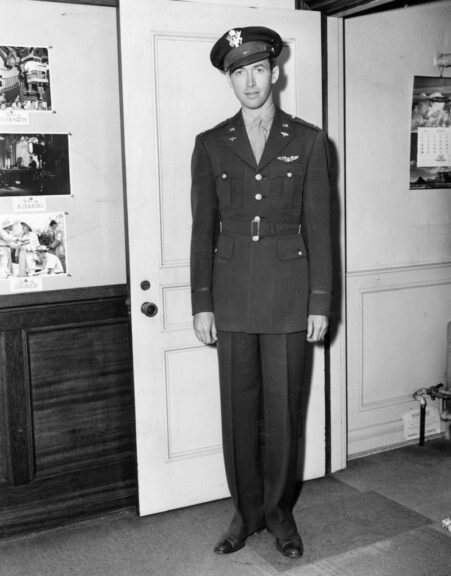
Portrait of American actor lieutenant colonel James Stewart (1908 – 1997), 1944. US Army/PhotoQuest/Getty Images.
Stewart’s determination — and his pre-war preparations — did not pay off immediately, however. The actor, who was fresh off his Best Actor win in 1940’s “The Philadelphia Story,” was initially drafted to appear in film reels and enlistment propaganda films — but eventually he demanded to see combat alongside his other draftees.
Stewart eventually got what he asked for, rising through the ranks from buck private to major in just four years and earning a spot in the cockpit of a B-24 Liberator heavy bomber known as Dixie Flyer. He flew dozens of missions over Germany, some as command pilot, and earned both a Distinguished Service Medal and a Distinguished Flying Cross.
But toward the end of the 8th Air Force’s Big Week in early 1944 — a six-day mission in late February originally named Operation Argument and designed to decimate the German Luftwaffe in preparation for the D-Day invasion — things went sideways. Stewart was on his 10th mission as a leader and serving as co-pilot when his plane was hit. The German flak left a sizable hole in the fuselage of his plane — just inches from his feet. And while he and his pilot were able to recover, when the smoke cleared from the cockpit, they had to watch as another in their squadron took a similar strike, lost a wing, and plummeted toward the ground.
Stewart was not the same after that and was eventually grounded. At the time, his condition was referred to as “flak-happy,” “shell-shock,” or “combat fatigue” — but today’s doctors might have diagnosed the decorated pilot with Post-Traumatic Stress Disorder.
“He wasn’t afraid of bombs or bullets. He was afraid of making a mistake and causing someone to die. That was his endless stress, and that’s what ended up grounding him,” Matzen wrote.
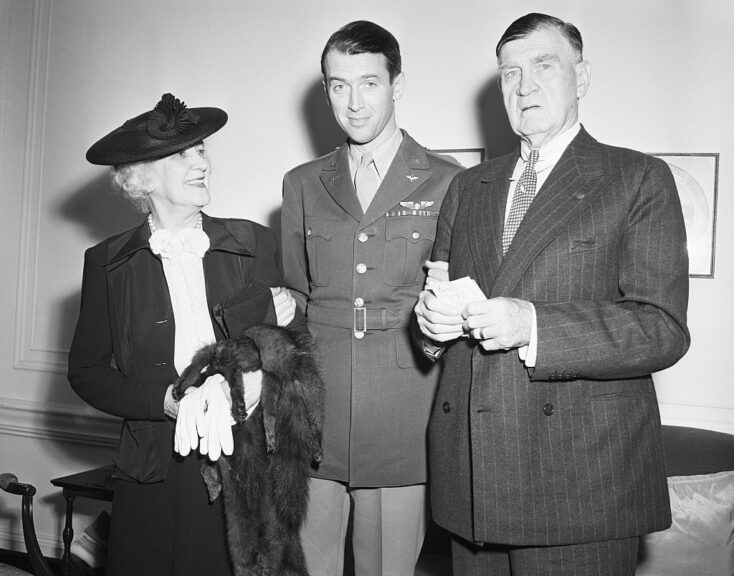
(Original Caption) 9/1/1945-New York, New York-Just like any serviceman returning from the war, Colonel James Stewart was greeted by his proud parents, who journeyed from Indiana, PA, to see their son after his arrival aboard the Queen Elizabeth. Getty Images.
He returned home to his proud parents in Pennsylvania. On the outside, he was a war hero; on the inside, he was nearly broken.
Surviving on little more than peanut butter and ice cream — he struggled to keep any solid foods down — Stewart’s already thin frame became painfully so. Still, he decided after a short time at home that what he really needed was to get back to work.
“I have to go back and face Hollywood. I’ve been away for five years, other people are taking my roles,” he said — but when he got there, he quickly realized that the landscape had changed and so had he. Stewart ended up sharing an apartment with fellow actor Henry Fonda, who had also recently returned after serving in the Pacific.
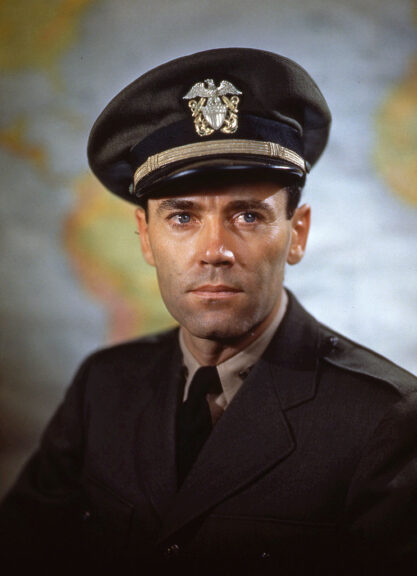
Lt. Henry Fonda (1905 – 1982) during his military service on board the USS Bearss, summer 1945. (Photo by PhotoQuest/Getty Images)
“I had been away from the film business, my MGM contract had run out and, frankly, not knowing how to get started again, I was just a little bit scared,” Stewart described the precarious nature of his situation in a 1987 interview with Guideposts. “Hank Fonda was in the same boat, and we sort of wandered around together, talking, flying kites and stuff. But nothing much was happening.”
Stewart got only one offer in those early weeks. His former boss and MGM exec Louis B. Mayer proposed a biopic capitalizing on the star’s military service. “Let’s do ‘The Jimmy Stewart Story’ — we can show you flying over Frankfurt, we can show you as a military hero,” Mayer said. Stewart’s answer was an unequivocal “No,” and he flatly refused to discuss the matter further.
Director Frank Capra, an Italian immigrant who had been naturalized after serving in World War I, had also spent time away from Hollywood during the war. As soon as Army Chief of Staff Gen. George Marshall got wind of Capra’s enlistment, he had him commissioned as a major and assigned to report to him personally.
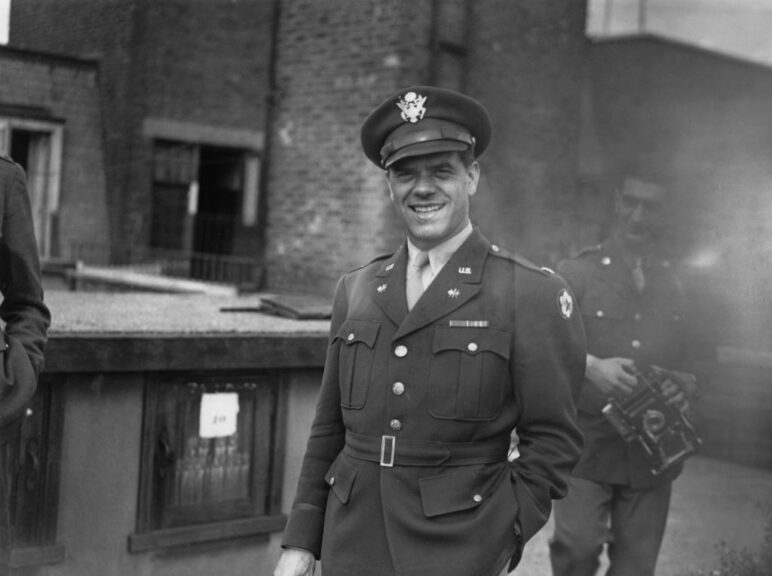
Italian-American film director Frank Capra (1897 – 1991) as a Lieutenant-Colonel in the US Army, during a stay in London, World War II, 19th August 1943. (Photo by Keystone/Hulton Archive/Getty Images)
“To win this war we must win the battle for men’s minds,” Marshall told Capra in one of their early meetings. “I want to nail down with you a plan to make a series of documented, factual-information films – the first in our history – that will explain to our boys in the Army why we are fighting, and the principles for which we are fighting.”
Capra protested, explaining that he had never made any film that could be considered a “documentary.”
Marshall responded with the gruff bluster that he was known for, saying, “Capra, I have never been chief of staff before. Thousands of young Americans have never had their legs shot off before. Boys are commanding ships today, who a year ago had never seen the ocean before.”
“I’m sorry, sir. I’ll make you the best damned documentary films ever made,” was Capra’s reply.
But when it was all over, Capra returned to Hollywood in much the same state as Stewart: adrift, and wondering if he still had what it took to deliver what the fans wanted.


